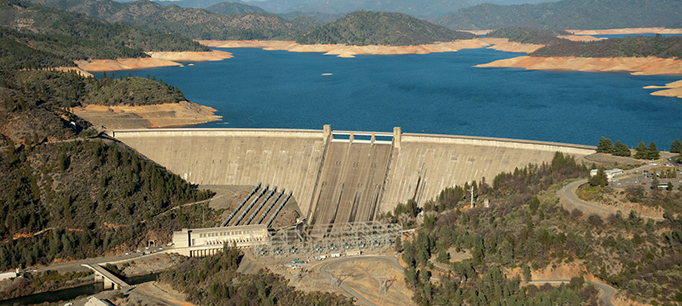Over the past few weeks, the state’s largest reservoir—Shasta—has been in the spotlight as managers struggle to meet multiple demands with dwindling reserves. Surface reservoirs are central to managing California’s water supplies for a variety of purposes. However, during extended droughts, when the amount of water in reservoirs gets low, water allocation decisions can involve difficult trade-offs. This year the trade-offs at Shasta are particularly challenging, since the survival of a run of endangered salmon may be on the line.
Most of Shasta’s water goes to agricultural water contractors in the Sacramento and San Joaquin Valleys. The reservoir generates abundant hydropower and supports a large recreation economy. Shasta, along with Folsom and Oroville Reservoirs, is also the principal source of water for controlling freshwater outflows from the Sacramento-San Joaquin Delta. These outflows are necessary to maintain water quality for both human uses as well as fish habitat.
Balancing all of these demands for Shasta water is made more complex by the needs of winter-run Chinook salmon—an endangered species that is edging close to extinction.
The Sacramento River was blocked by Shasta Dam in 1944. This shut off access to spawning grounds for millions of winter-run salmon that historically migrated to the river’s headwaters in late winter. Their eggs—deposited in the gravels—survived the hot California summers because of the abundant cold spring flows in these headwaters.
Today, the dense, cold water that collects at the bottom of the reservoir in winter and early spring is the only available source of cold water for these fish. Spawning is now restricted to a relatively short stretch of the Sacramento River immediately below the reservoir where temperatures are kept low enough by cold water releases.
In late summer of 2014, the water released from Shasta was too warm, resulting in the death of almost all the winter-run Chinook salmon eggs. According to a report by the U.S. Bureau of Reclamation, temperature models used to forecast dam operations failed to fully account for reservoir water temperatures and the performance of gates used to selectively draw water from various depths. By the time the errors were discovered, early season water releases for irrigation had used up available cold water.
This year the weather circumstances are roughly the same: low winter and spring inflows and unusually warm temperatures. In a report to the State Water Resources Control Board in early spring, the U.S. Bureau of Reclamation provided assurances that temperature needs for winter-run Chinook could be met while allowing water releases for irrigators and meeting water quality requirements in the Delta.
But in late May, reservoir managers revealed that winter-run salmon eggs were at risk due to high temperature releases for a second consecutive year. This year’s miscalculations were different than last year’s. Operations staff failed to incorporate water temperature data that showed that the lake had warmed rapidly in the spring. As before, these errors led to overly optimistic projections for available water.
State and federal officials have committed to trying to stave off another complete loss of winter-run Chinook, acknowledging that failing to do so may lead to extinction. They say themselves that this is going to be no easy task given the warmth of water in the reservoir.
These difficulties in managing Shasta Reservoir highlight a significant policy challenge that needs to be addressed during this drought, and that also has implications for managing future droughts.
Uncertainty—whether from data collection or failures of technical models to adequately represent extreme conditions—needs to be more explicitly integrated into decision-making. When water supplies are very limited, there is great pressure to meet all competing demands to the maximum extent possible, leaving little room for adjustment to unanticipated conditions or events. This is especially true for cold water in reservoirs because early season releases for irrigation or other uses limits options to adjust later in the season.
To incorporate uncertainty into drought planning, priorities need to be clearly defined, and a margin of safety established for top priorities, such as preventing extinction of endangered species.
A greater margin of safety would likely have prevented the loss of winter-run Chinook salmon in 2014 and helped avert the challenges this year. To be sure, this would have meant increased water scarcity for some downstream irrigators. But this scarcity would not be permanent, since the rains will eventually return. And policies such as crop insurance and emergency drought support can lessen the financial costs of water shortages to farmers. For the salmon, there will be no second chance: extinction is permanent, regardless of whether it rains again.


